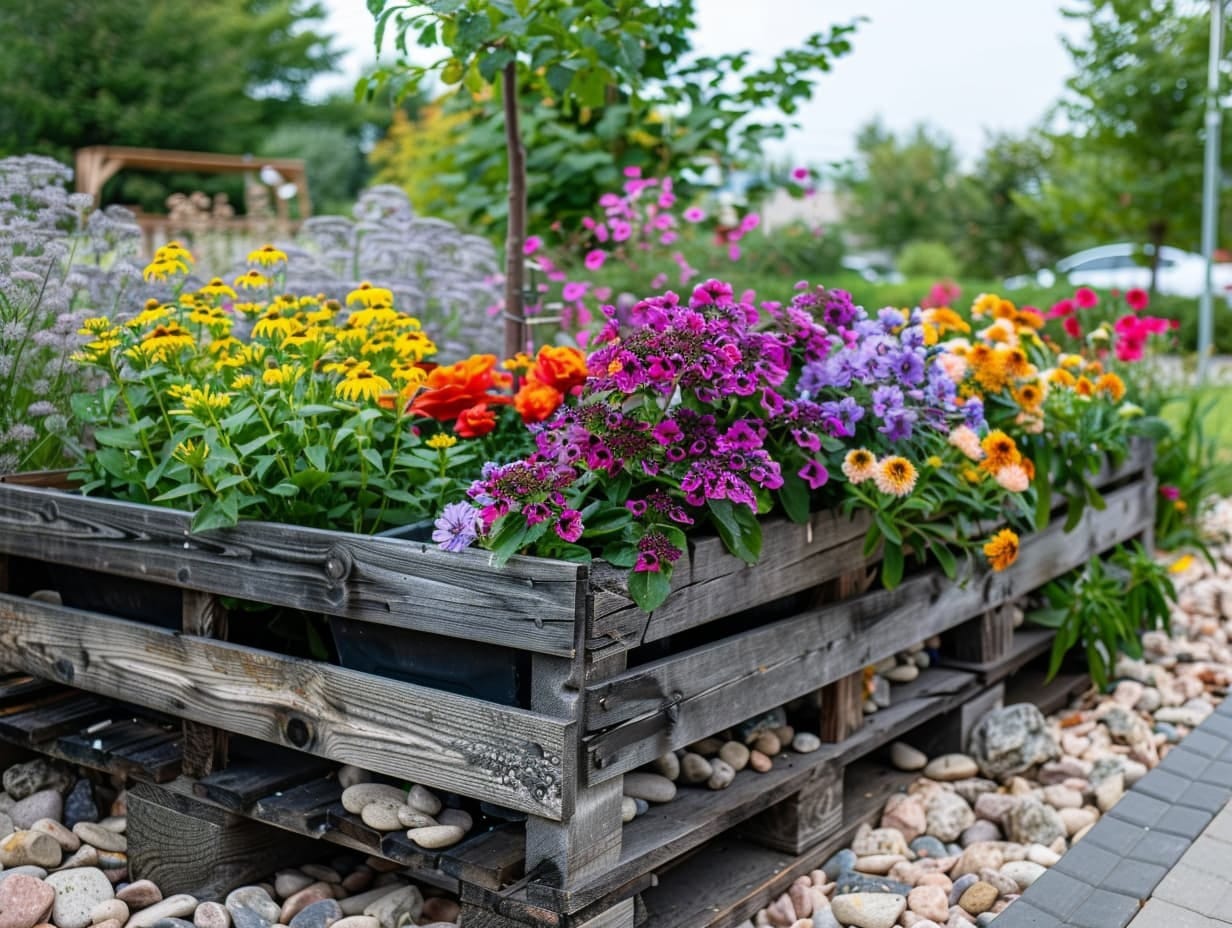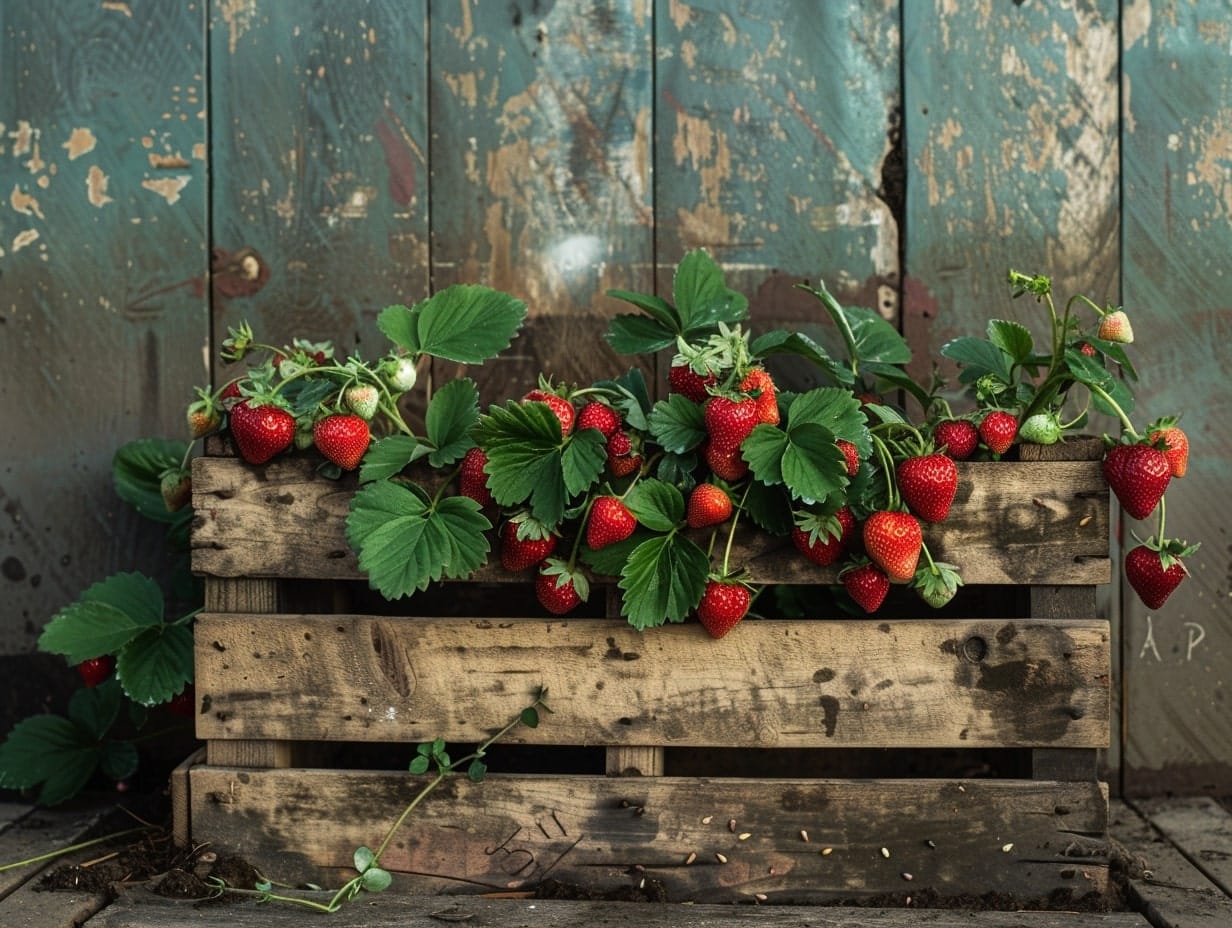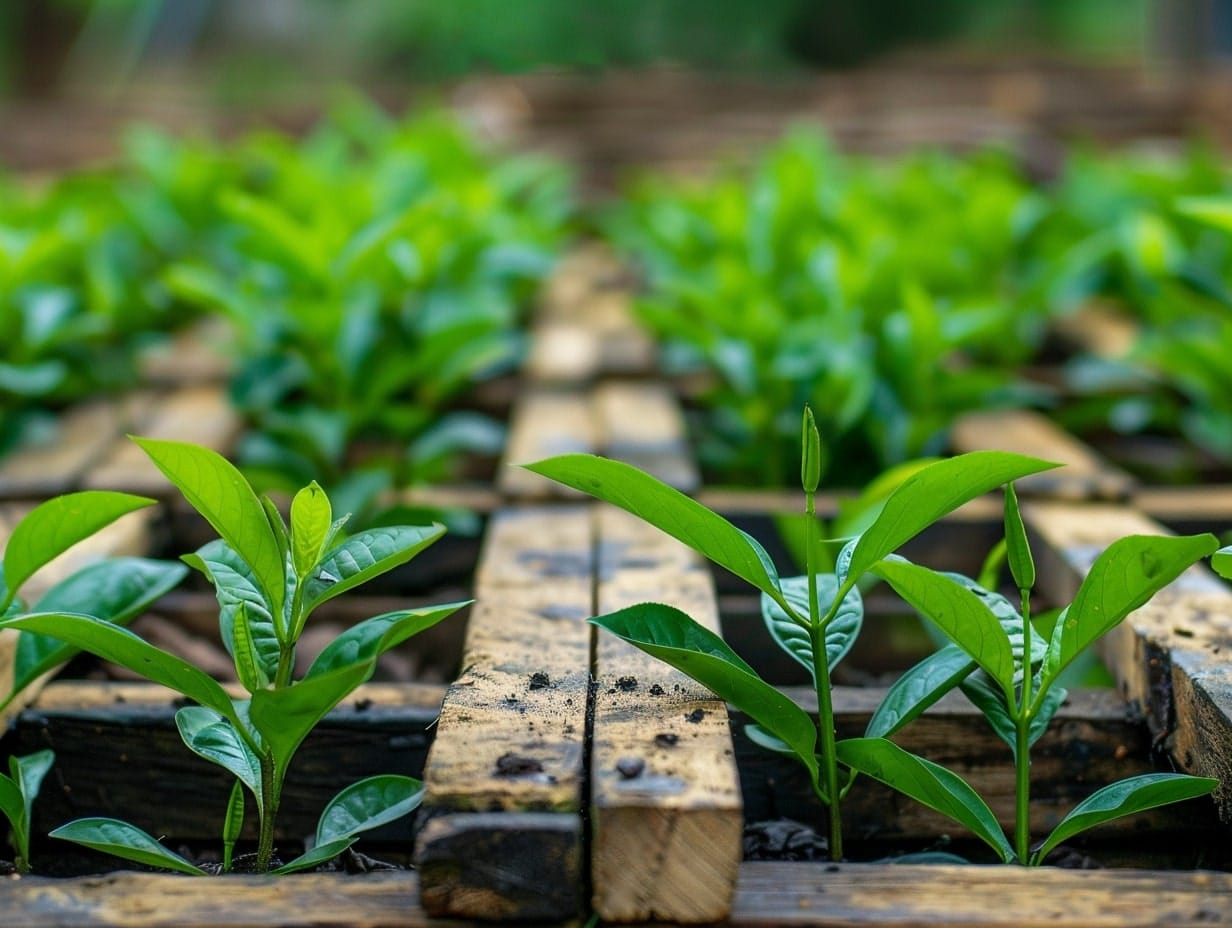When you buy products via links on our website, we might receive an affiliate commission. Learn more
18 Easy and DIY Pallet Garden Ideas for Your Yard

Welcome to our guide on transforming ordinary pallets into beautiful and functional garden features. Discover creative ways to enhance your yard with 18 easy and DIY pallet garden ideas.
Whether you have a small balcony or a spacious backyard, these projects will inspire you to make the most of your space. From vertical flower gardens and herb sections to mobile planters and decorative fences, pallets offer endless possibilities for gardening enthusiasts.
Each project is designed to be easy and budget-friendly, making gardening accessible and enjoyable for everyone. Let's dive in and explore how you can elevate your outdoor area with these innovative pallet garden ideas.
Stack Pallets Vertically to Create a Vertical Flower Garden

Start by securing a pallet vertically against a wall or a sturdy frame. Fill each slat with high-quality soil and plant different types of flowers in the gaps between the wooden slats. Choose a mix of trailing, upright, and filler plants to create a lush, cascading effect.
Ensure the pallet has proper drainage by adding landscape fabric or small holes at the back. This method not only enhances small spaces but also brings vibrant color and life to your garden area.
Segment Pallets Into Sections to Grow Different Herbs

Begin by placing the pallet flat on the ground or mounting it slightly elevated. Use wooden dividers or sturdy plastic sheets to create distinct compartments within the pallet’s structure.
Fill each section with nutrient-rich soil and plant different herbs, such as basil, thyme, rosemary, and parsley. Label each segment for easy identification and maintenance. This method allows you to keep herbs organized and prevents invasive growth.
Use a Pallet to Plant Rows of Strawberries

Using a pallet to plant rows of strawberries is an excellent way to maximize space and ensure a bountiful harvest. Start by placing the pallet flat on the ground or slightly elevated. Line the bottom and sides with landscape fabric to retain soil while allowing drainage.
Fill the pallet with a high-quality, well-draining soil mix. Plant strawberry seedlings in the gaps between the slats, ensuring they have enough space to grow and spread. Water regularly and place the pallet in a sunny spot.
Fill a Vertical Pallet With Different Succulents

Creating a vertical succulent garden using a pallet is a stylish and low-maintenance project. Begin by securing the pallet vertically against a wall or sturdy support. Line the back and sides with landscape fabric or burlap to hold soil in place.
Fill the pallet with a well-draining cactus or succulent soil mix. Carefully plant a variety of succulents in the gaps between the slats, choosing different shapes, colors, and sizes for visual interest. Water the succulents sparingly, allowing the soil to dry out completely between waterings.
Modify a Pallet Into a Small, Raised Bed for Vegetables

Start by selecting a sturdy pallet and placing it in your desired location, ensuring it has ample sunlight. Line the bottom with landscape fabric to retain soil while allowing excess water to drain. Fill the pallet with nutrient-rich soil, ideal for vegetable growth.
Plant seeds or seedlings in the gaps between the slats, choosing compact vegetables like lettuce, radishes, or spinach. This setup elevates your garden, making it easier to manage and reducing the risk of pests, while promoting healthy vegetable growth.
Secure a Pallet Against a Wall and Use It for Shelving Potted Plants

First, secure the pallet vertically against a sturdy wall using heavy-duty brackets or screws, ensuring it is stable and level. Sand down any rough edges to prevent splinters.
Place small potted plants on each slat, arranging them in an aesthetically pleasing manner. You can also attach hooks or small shelves to the pallet for additional display options.
Convert a Pallet Into a Handy Bench for Organizing Garden Tools

Begin by selecting a sturdy pallet and sanding down any rough edges. Cut the pallet into two sections: one for the bench seat and one for the backrest.
Attach the backrest section vertically to the seat using strong brackets or screws. Add legs for stability if needed. Install hooks, pegs, or small shelves on the backrest to hang and organize your garden tools.
Paint or stain the bench for a finished look. This bench provides a comfortable place to sit and keeps your gardening essentials within easy reach.
Suspend a Pallet Horizontally From Chains and Use It to Hang Small Planters

Start by selecting a sturdy pallet and ensuring it is in good condition. Attach four heavy-duty eye hooks to each corner of the pallet.
Securely fasten four chains to the eye hooks and attach the other ends to a strong overhead support, such as a pergola or a sturdy tree branch, ensuring the pallet is level.
Hang small planters from the pallet slats using hooks or S-hooks. This floating garden display not only saves space but also adds a dynamic and decorative element to your outdoor area.
Line Up Several Pallets to Create a Private Fence

Start by gathering several sturdy pallets, ensuring they are of similar size and in good condition. Stand the pallets upright, aligning them side by side along the desired fence line. Secure the pallets to each other using heavy-duty brackets or screws for stability.
For added security, anchor the pallets to wooden or metal posts driven into the ground.
You can enhance the privacy by attaching additional wood slats or by growing climbing plants like ivy or jasmine along the fence. This DIY fence provides a charming and functional barrier for your outdoor space.
Add Wheels to Pallets and Convert Them Into Mobile Gardens

Start by selecting a sturdy pallet and attaching heavy-duty caster wheels to each corner using screws or bolts. Ensure the wheels lock to keep the garden stationary when needed. Line the bottom and sides of the pallet with landscape fabric to retain soil while allowing drainage.
Fill the pallet with high-quality soil and plant a variety of vegetables, herbs, or flowers in the gaps between the slats.
This mobile garden can be easily moved to different spots to optimize sunlight exposure or to create flexible garden layouts, perfect for small or urban spaces.
Design a Pallet Garden in Your Balcony to Maximize Space

Begin by selecting a sturdy pallet and cleaning it thoroughly. Secure the pallet vertically against a balcony wall or railing using brackets or strong rope. Line the back and sides with landscape fabric to hold soil in place.
Fill the pallet with a high-quality potting mix, ensuring good drainage. Plant a variety of herbs, flowers, or small vegetables in the gaps between the slats.
For added convenience, hang small potted plants or garden tools on hooks attached to the pallet. This setup not only saves floor space but also creates a vibrant, green focal point on your balcony.
Cut Pallets Into Smaller Sections to Line Garden Pathways or Flower Beds

Cut the planks into smaller sections, depending on the height you want for your garden borders. Sand the edges to smooth out any rough spots and prevent splinters.
Arrange the cut planks vertically along the edges of your pathway or flower bed, ensuring they are evenly spaced. Secure the planks into the ground using stakes or by digging a shallow trench to hold them in place.
Plant Butterfly-Attracting Flowers in a Pallet to Create a Butterfly Garden

Start by positioning a sturdy pallet flat on the ground or slightly elevated in a sunny spot. Line the bottom and sides with landscape fabric to retain soil. Fill the pallet with a well-draining, nutrient-rich soil mix.
Plant a variety of butterfly-attracting flowers such as milkweed, lantana, zinnias, and coneflowers in the gaps between the slats. Ensure a mix of nectar-rich flowers to provide continuous blooms throughout the season.
Create a Pallet Garden Bench to Place Planters in Your Garden

Creating a pallet garden bench that incorporates planters is a functional and decorative addition to any garden.
Start by selecting two sturdy pallets. For the planters, cut square or rectangular openings into the seat of the bench, ensuring they are large enough to fit small pots securely. Insert your planters into these openings. Paint or stain the bench for added durability and aesthetic appeal.
Stand a Pallet Up and Use It as a Trellis for Climbing Plants Like Cucumber and Peas

Start by selecting a sturdy pallet and standing it upright in your garden. Secure it firmly by anchoring it into the ground with stakes or by attaching it to a fence or wall for added stability. Ensure the pallet is positioned in a spot that receives ample sunlight.
Plant your cucumber or pea seeds at the base of the pallet. As the plants grow, guide their tendrils to weave through the slats, providing them with support to climb upwards.
Plant a Selection of Tea Herbs in a Pallet

Start by positioning a sturdy pallet flat on the ground or mounting it vertically against a wall. Line the bottom and sides with landscape fabric to hold the soil. Fill the pallet with a high-quality, well-draining potting mix.
Plant a variety of tea herbs such as chamomile, peppermint, lemon balm, and lavender in the gaps between the slats. Place the pallet in a sunny spot where the herbs can thrive.
Arrange Flowers by Colors in a Pallet for a Rainbow Effect

Select flowers in a spectrum of colors, such as red petunias, orange marigolds, yellow pansies, green foliage plants, blue lobelias, indigo salvias, and violet pansies. Plant them in rows according to their colors, from top to bottom or side to side, creating a rainbow effect.
Ensure the pallet is placed in a sunny spot and water the plants regularly. This colorful arrangement will brighten any garden space and create a stunning visual impact.
Construct a Decorative Fence Around Your Garden Using Painted or Varnished Pallets

Start by gathering several sturdy pallets of the same size. Paint or varnish them in your desired colors to match your garden's aesthetic. For a more artistic touch, consider using different colors for a vibrant look or stencils to add patterns.
Stand the pallets upright, side by side, along your garden's perimeter. Secure them together using heavy-duty brackets or screws, and anchor them into the ground with stakes or posts for stability. This decorative fence not only defines your garden area but also adds a charming, personalized touch.
